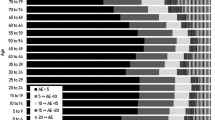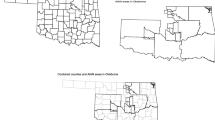Abstract
The recently finalized changes to the disclosure avoidance policies of the US Census Bureau for the 2020 census, grounded in differential privacy, have faced increasing criticism from demographers and other social scientists. Scholars have found that estimates generated via census-released test data are accurate for aggregate total population statistics of larger spatial units (e.g., counties), but introduce considerable discrepancies for estimates of subgroups. At present, the ramifications of this new approach remain unclear for rural populations. In this brief, we focus on rural populations and evaluate the ability of the finalized differential privacy algorithm to provide accurate population counts and growth rates from 2000 to 2010 across the rural–urban continuum for the total, non-Hispanic white, non-Hispanic Black, Hispanic or Latino/a, and non-Hispanic American Indian population. We find the method introduces significant discrepancies relative to the prior approach into counts and growth rate estimates at the county level for all groups except the total and non-Hispanic white population. Further, discrepancies increase dramatically as we move from urban to rural. Thus, the differential privacy method likely introduced significant discrepancies for rural and non-white populations into 2020 census tabulations.





Similar content being viewed by others
Data Availability
The data utilized in our study is available through the National Historical Geographic Information System (NHGIS, https://www.nhgis.org/).
Code Availability
Our code is available upon request by interested parties. Requests for our code should be sent to the corresponding author.
Notes
Due to population counts of zero, the calculation of ratios of relative discrepancies, growth rates, and subsequent growth rate ratios resulted in a number of inestimable rates and rate ratios due to the presence of zeroes in denominators. These observations have been treated as missing for this analysis and include 1 county for Hispanic or Latina/o, 33 counties for non-Hispanic Black, and 7 counties for non-Hispanic American Indian for relative differences in 2010 statistics. For growth rate ratios, this includes 1 county for Hispanic or Latina/o, 74 counties for non-Hispanic Black, and 13 counties for non-Hispanic American Indian.
A metropolitan county is defined by the Office of Management and Budget as a county with either a core population of at least 50,000, or that is connected to a core metropolitan county by greater than 25% of commuting (Office of Management and Budget, 2010). Please see https://www.ers.usda.gov/data-products/rural-urban-continuum-codes/documentation/ for a map of RUCC distribution across the United States.
References
Abowd, J. M., & Schmutte, I. M. (2019). An economic analysis of privacy protection and statistical accuracy as social choices. American Economic Review, 109(1), 171–202. https://doi.org/10.1257/aer.20170627
Bolin, J. N., Bellamy, G. R., Ferdinand, A. O., Vuong, A. M., Kash, B. A., Schulze, A., & Helduser, J. W. (2015). Rural healthy people 2020: new decade, same challenges. Journal of Rural Health, 31(3), 326–333. https://doi.org/10.1111/jrh.12116
Brooks, M. M., Mueller, J. T., & Thiede, B. C. (2020). County Reclassifications and rural-urban mortality disparities in the United States (1970–2018). American Journal of Public Health, 110(12), 1814–1816. https://doi.org/10.2105/AJPH.2020.305895
Brown, D. L., & Schafft, K. A. (2011). Rural People and Communities in the 21st Century: Resilience and Transformation. Polity Press. https://doi.org/10.1111/ruso.12057_2
U.S. Census Bureau. (1994) Geographic Area Reference Manual (GARM). U.S. Department of Commerce, Economics and Statistics Administration.
U.S. Census Bureau. (2021a) Census Bureau sets key parameters to protect privacy in 2020 census results. Census Bureau release number CB21-CN.42. Accessed at https://www.census.gov/newsroom/press-releases/2021/2020-census-key-parameters.html, Access on August 19, 2021
U.S. Census Bureau. (2021b) 2020 Population and Housing State Data. Accessed at https://www.census.gov/library/visualizations/interactive/2020-population-and-housing-state-data.html, Accessed on August 19, 2021.
Cosby, A. G., McDoom-Echebiri, M. M., James, W., Khandekar, H., Brown, W., & Hanna, H. L. (2019). Growth and persistence of place-based mortality in the United States: The rural mortality penalty. American Journal of Public Health, 109(1), 155–162.
Crosby, R. A., Wendel, M. L., Vanderpool, R. C., & Casey, B. R. (2012). Rural Populations and Health: Determinants, Disparities, and Solutions. John Wiley & Sons.
Gagnon, D. J., & Mattingly, M. J. (2018). Racial/Ethnic test score gaps and the urban continuum. Journal of Research in Rural Education (online), 33(2), 1–16.
Greenberg, A. (2017). How one of Apple’s key privacy safeguards falls short. Wired. Published September 15, 2017. Accessed at https://www.wired.com/story/apple-differential-privacy-shortcomings/, Accessed on August 19, 2021.
Hafner, K. (2021) Virginia’s new census data is distorted at local levels, analysts say: ‘It can’t be accepted as fact’. The Virgina-Pilot. August 18, 2021.
Hauer, M. E., & Santos-Lozada, A. R. (2021). Differential privacy in the 2020 Census will distort COVID-19 rates. Socius. https://doi.org/10.1177/2378023121994014
Isserman, A. M., & Westervelt, J. D. (2006). 15 million missing numbers: Overcoming employment suppression in County Business Patterns data. International Regional Science Review, 29(3), 311–335. https://doi.org/10.1177/0160017606290359
James, W., & Cossman, J. S. (2017). Long-term trends in Black and White mortality in the rural United States: Evidence of a race-specific rural mortality penalty. The Journal of Rural Health, 33(1), 21–31.
Johnson, K. M., & Lichter, D. T. (2008). Natural increase: A new source of population growth in emerging hispanic destinations in the United States. Population and Development Review, 34(2), 327–346. https://doi.org/10.1111/j.1728-4457.2008.00222.x
Johnson, K. M., & Lichter, D. T. (2010). Growing diversity among America’s children and youth: Spatial and temporal dimensions. Population and Development Review, 36(1), 151–176. https://doi.org/10.1111/j.1728-4457.2010.00322.x
Kenny, C. T., Kuriwaki, S., McCartan, C., Roseman, E., Simko, T., Imai, K. (2021). The impact of the U.S. Census Disclosure Avoidance System on redistricting and voting rights analysis. Working Paper. https://alarm-redist.github.io/posts/2021-05-28-census-das/Harvard-DAS-Evaluation.pdf
Lee, B. A., & Sharp, G. (2017). Ethnoracial diversity across the rural-urban continuum. The ANNALS of the American Academy of Political and Social Science, 672(1), 26–45.
Lichter, D. T. (2012). Immigration and the new racial diversity in rural America. Rural Sociology, 77(1), 3–35.
Liebler, C. A., & Ortyl, T. (2014). More than one million new American Indians in 2000: who are they? Demography, 51(3), 1101–1130. https://doi.org/10.1007/s13524-014-0288-7
Manson, S., Schroeder, J., Van Riper, D., Kugler, T. & Ruggles, S. (2021) IPUMS National Historical Geographic Information System: Version 15.0 [Database] https://doi.org/10.18128/D050.V14.0
Mervis, J. (2019). Can a set of equations keep U.S. census data private? Science. https://doi.org/10.1126/science.aaw5470
Mueller, J. T., McConnell, K., Burow, P. B., Pofahl, K., Merdjanoff, A. A., & Farrell, J. (2021). Impacts of the COVID-19 pandemic on rural America. Proceedings of the National Academy of Sciences of the United States of America, 118(1), 1–6. https://doi.org/10.1073/pnas.2019378118
Office of Management and Budget (2010). 2010 Standard for delineating metropolitan and micropolitan statistical areas; Notice. Technical Report Number 123. Executive Office of the Vice President of the United States.
Van Riper, David; Kugler, Tracy and Ruggles (2020) Disclosure Avoidance in the Census Bureau’s 2010 Demonstration Data Product. In Privacy in Statistical Databases (Eds. Josep Domingo-Ferrer and Krishnamurty Muralidhar)
Ruggles, S., Fitch, C., Magnuson, D., & Schroeder, J. (2019). Differential privacy and census data: implications for social and economic research. AEA Papers and Proceedings, 109, 403–408. https://doi.org/10.1257/pandp.20191107
Santos-Lozada, A. R. (2021). Changes in census data will affect our understanding of infant health. Socius. https://doi.org/10.1177/23780231211023642
Santos-Lozada, A. R., Howard, J. T., & Verdery, A. M. (2020). How differential privacy will affect our understanding of health disparities in the United States. Proceedings of the National Academy of Sciences. https://doi.org/10.1073/pnas.2003714117
Schneider, M. (2021, May 27). Census Bureau’s use of “syntethic data” worries researchers. The Washington Post. Retrieved from https://www.washingtonpost.com/national/census-bureaus-use-of-synthetic-data-worries-researchers/2021/05/27/ac061d04-bf02-11eb-922a-c40c9774bc48_story.html
Thiede, B., Kim, H., & Valasik, M. (2018). The spatial concentration of America’s rural poor population: A postrecession update. Rural Sociology, 83(1), 109–144.
Tickamyer, A., Warlick, J., & Sherman, J. (Eds.) (2017) Rural poverty in the United States. Columbia University Press
USDA. (2013). Rural-Urban Continuum Codes. Retrieved February 2, 2020, from https://www.ers.usda.gov/data-products/rural-urban-continuum-codes.aspx
Winkler, R. L., Butler, J. L., Curtis, K. J., & Egan-Robertson, D. (2021). Differential privacy and the accuracy of county-level net migration estimates. Population Research and Policy Review. https://doi.org/10.1007/s11113-021-09664-5
Zayatz, L. (2007). Disclosure avoidance practices and research at the U.S. Census Bureau: an update. Journal of Official Statistics, 23(2), 253–265.
Acknowledgements
The authors are thankful to the IPUMS and NHGIS for making the materials required for this publication accessible through their platforms.
Funding
Alexis R. Santos-Lozada is funded by the Social Science Research Institute and PRI at the Pennsylvania State University. PRI is supported by a grant from the Eunice Kennedy Shriver National Institute of Child Health and Human Development (P2CHD041025). Santos-Lozada is also funded by a Diversity Supplement from the National Institute on Aging through the Interdisciplinary Network on Rural Population Health and Aging (R24-AG065159 and R24-AG065159-03S1).
Author information
Authors and Affiliations
Contributions
Mueller and Santos-Lozada had full access to all data and take full responsibility for the integrity of the data and the accuracy of the data analysis. Mueller and Santos conceptualized and designed the study, acquired, and analyzed the data. Both authors contributed to the data interpretation. Mueller drafted the original manuscript and the revised versions. Santos contributed to all versions of the manuscript.
Corresponding author
Ethics declarations
Conflict of interest
The authors have no conflict to disclose.
Ethical approval
Because these data are country-level aggregate counts, this study is not considered to be research involving human subjects as defined by US regulation (45 CFR 46.102(d)).
Consent to Participate
Not applicable.
Consent for Publication
All authors have read and approved this manuscript for publication.
Additional information
Publisher's Note
Springer Nature remains neutral with regard to jurisdictional claims in published maps and institutional affiliations.
Rights and permissions
About this article
Cite this article
Mueller, J.T., Santos-Lozada, A.R. The 2020 US Census Differential Privacy Method Introduces Disproportionate Discrepancies for Rural and Non-White Populations. Popul Res Policy Rev 41, 1417–1430 (2022). https://doi.org/10.1007/s11113-022-09698-3
Received:
Accepted:
Published:
Issue Date:
DOI: https://doi.org/10.1007/s11113-022-09698-3




